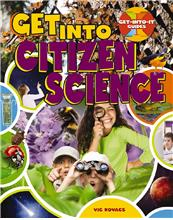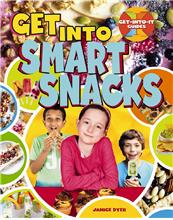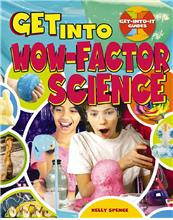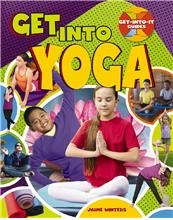| ________________
CM . . . . Volume XXIV Number 20. . . . January 26, 2018
excerpts:
Fourteen titles now comprise the "Get-into-It Guides" series which introduces readers to a variety of interests or hobbies. Most of the books begin with a brief history of the featured topic, followed by a list of supplies needed for the activity. These four titles, however, delve straight into the topic after the history segment. The majority of each title is devoted to the "how to" of the activity, itself, with basic step-by-step instructions. Several of the activities require an adult’s supervision for safety reasons. There are plenty of text boxes, including one entitled "Did You Know?" which provides topic-related trivia. Though the series is designed for elementary school children, the vocabulary varies too much from the simple to the more advanced, and some of the explanations are just too complicated for the target audience. The text is enhanced with abundant illustrations and photographs, but the loud, vivid colours and the busy and crowded layout of the books occasionally have a jarring effect. Photos in these titles show children at the top end of the target audience and even a slight bit older, and, though older readers might find the content interesting, they would likely find the books’ style too juvenile. A table of contents, a glossary and a brief list of books and websites (some of which have videos) are included. Citizen science is a growing movement in which members of the general public volunteer to collect data to increase scientific knowledge in a variety of fields. Data collection through public participation not only saves researchers time and money, but the data also is used to drive policy. Some examples of data collection include tracking animal populations and migration routes. In Get into Citizen Science, readers will learn how to record their data in a field journal and to use other cataloguing methods, such as tallies, sketches, photos and mobile apps. There are plenty of examples of current projects, such as Naturalist which now has 400,000 people contributing to more than 9,000 projects. Others include BioBlitz, in which citizens create a “snapshot” of biodiversity over a weekend (in Toronto in 2014, two spiders, new to Canada, were discovered during a BioBlitz event); The Great Backyard Bird Count; and Urban Buzz, a project used to track climate change through the observation of cicadas which are sensitive to environmental factors. But not all projects involve flora and fauna. Some, such as Comet Hunters and Cosmoquest are related to the solar system, Globe at Night studies light pollution while both NASA GLOBE Observe and Cyclone Center are related to weather. Get into Smart Snacks encourages readers to eat healthy snacks, enjoy a well-balanced diet with a wide variety of foods from the different food groups, to hydrate with plenty of water, and to avoid over-processed and junk food by reading the labels on food packaging for commonly used additives. Kitchen terms, such as whisking, grating and mincing, are explained along with accompanying photographs (although one omission is how to separate an egg, a skill readers will have to know in order to make some of the recipes included in the book). There are some kitchen safety tips along with a cautionary note that some of the tasks require an adult’s supervision, specifically the use of knives, a blender and a toaster oven. The majority of this title is devoted to recipes for healthy snacks, both sweet and savoury. Some of these include guacamole, frozen fruit pops, kale chips, hummus dip, energy bars, and sweet potato and bean burritos. Children in the photos appear to be middle school-aged, but the font size and overall appearance of the book suggest a younger audience. Smart snacking is a great idea, and so perhaps this title will inspire kids to search for more healthy recipes online or in their parents’ cookbooks. Adult/parental supervision is a must in many of the experiments in Get into Wow-Factor Science as a few can be dangerous and require the use of safety goggles, and others require the use of matches or a kitchen stove or chemicals such as hydrogen peroxide. Step-by-step instructions for more than 20 experiments are included, with topics ranging from electricity and magnetism to capillary action and optical illusions. Most of them take only 10-15 minutes to conduct. Kids will have fun creating heat-sensitive slime, elephant toothpaste and a soda explosion, among others. Each experiment also comes with a list of materials and safety tips, and, occasionally, there are suggestions for variations of the experiment as well as an explanation of how the experiment works. A few of the necessary materials are not readily found in a household (e.g. borax, neodymium magnets and iron oxide powder) so a trip to a store might be in order, and, though the experiments look like great fun, there are many other books currently available which contain a variety of similar “wow-factor” experiments. Get into Yoga provides a history of this ancient practice followed by a brief explanation of a few main types: Hatha, Ashtanga, Iyengar and Vinsaya. Yoga is said to strengthen the body, quiet the mind and release stress. The five points of yoga, as taught by Swamiji, a great yoga teacher, are exercise, breathing, relaxation, positive thinking and meditation. Unfortunately, this title does not adequately explain what meditation is. Other topics in this title include the chakra system, practising mindfulness and incorporating mantras in order to quiet the “monkey mind”. Most of the book, however, is devoted to mudras, breathing techniques and the various poses- seated, standing, strength and balance, grounding, twisting, and relaxation. Step-by-step instructions and accompanying photographs for each of the poses are provided. Though this title is a good introduction to yoga, the yogic practice is one best learned by doing to ensure that the poses are done correctly. Generally, these four titles are a slight improvement over the other books in the series, possibly due to the nature of the specific topics, but they are quite pricy. Recommended with Reservations. Gail Hamilton is a retired teacher-librarian in Winnipeg, MB.
Next Review |
Table of Contents for This Issue
- January 26, 2018. |



